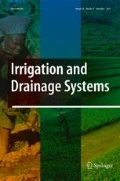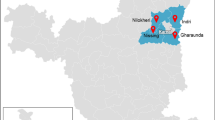Abstract
The increasing scarcity of water in California and the rising cost of compliance with environmental regulations are motivating some farmers in the San Joaquin Valley to sell their land and water, and discontinue production of irrigated crops. In the summer of 2004, all landowners in the 3,700-ha Broadview Water District decided to sell their land to Westlands Water District. The land sales have been completed and Westlands has acquired Broadview's water supply contract. Farmland in Broadview will no longer be irrigated. We describe what motivated the purchase and sale of land and water in Broadview and discuss the potential gains to participants. We describe also the potential public benefits that include an increase in economic activity and environmental enhancement in the San Joaquin Valley. Farm workers displaced by land retirement in Broadview will find employment in the Westlands Water District. Tenant farmers in Broadview will need to find other land on which to continue farming after the land sales are completed. The challenge they face is caused partly by a regional trend toward greater production of perennial crops that is leaving less land available for annual leases.
Similar content being viewed by others
References
Anderson, T.L. & Landry, C.J. 2001. Exporting Water to the World. Water Resources Update 118: 60–67.
Ayars, J.E., Wichelns, D. & Cone, D. 1998. Water management principles for drainage reduction and a case study of the Broadview Water District, California. In: L.M. Dudley & J.C. Guitjens (Eds.) Agroecosystems and the Environment: Sources, Control, and Remediation of Potentially Toxic, Trace Element Oxyanions. San Francisco, California. Pacific Division of the American Association for the Advancement of Science.
Beede, R.H., Kallsen, C.E., Freeman, M.W., Ferguson, L., Holtz, B.A., Klonksy, K.M. & De Moura, R.L. 2004. Sample costs to establish and produce pistachios, San Joaquin Valley, University of California Cooperative Extension, Davis, California.
Bettner, T.L. 2004. Socio-economic impacts of land retirement in Westlands Water District. In: R.R. Murray, K. Jacobson, and S.S. Anderson (Eds.) Water Rights and Related Water Supply Issues. U.S. Committee on Irrigation and Drainage, Denver, Colorado.
California Department of Finance, 2002. California County Profiles. Sacramento, CA. Also available at http://www.dof.ca.gov/HTML/FS_DATA/profiles/pf_home.htm.
California, State Water Resources Control Board, 1987. Regulation of agricultural drainage to the San Joaquin River. SWRCB Order Number W.Q. 85–1. Technical Committee Report, Sacramento, 192 pages.
Campbell-Mathews, M., Vargas, R., Wright, S., Collar, C., Canevari, M., Jackson, L., Marsh, B., Klonsky, K. & Livingston, P. 1999. Sample costs to produce winter forage, San Joaquin Valley. University of California Cooperative Extension, Davis, California.
Carter, H.O., Vaux, H.J. Jr. & Scheuring, A.F. (Eds.) 1994. Sharing Scarcity: Gainers and Losers in Water Marketing. University of California Agricultural Issues Center, Davis, California.
Department of the Interior (DOI), 1997. Central Valley Project Improvement Act Section 3408(h): Land Retirement Program Interim Guidelines. Interagency Land Retirement Team, Fresno, California.
Department of the Interior (DOI). 2003. Implementation of the Central Valley Project Improvement Act 10-Year Report, Fiscal Years 1993–2002. Bureau of Reclamation, Sacramento, California.
Duncan, R.A., Verdegaal, P.S., Holtz, B.A., Klonksy, K.M. & De Moura, R.L. 2002. Sample costs to establish an almond orchard and produce almonds, San Joaquin Valley North, University of California Cooperative Extension, Davis, California.
Easter, K.W. & Hearne, R. 1995. Water markets and decentralized water resources management: International problems and opportunities. Water Resources Bulletin 31(1): 9–20.
Eggebo, S.L., Higgins, K.F., Naugle, D.E. & Quamen, F.R. 2003. Effects of CRP field age and cover type on ring-necked pheasants in eastern South Dakota. Wildlife Society Bulletin 31(3): 779–785.
Fresno County, 2003. Agricultural Crop and Livestock Report. Department of Agriculture, Fresno, California. Available at: http://www.co.fresno.ca.us/4010/agwelcm.htm.
Hooker M.A. & Alexander W.E. 1998. Estimating the Demand for Irrigation Water in the Central Valley of California. Journal of the American Water Resources Association (JAWRA) 34(3): 497–505.
Howitt, R.E. & Lund, J.R. 1999. Measuring the economic impacts of environmental reallocations of water in California. American Journal of Agricultural Economics 81(5): 1268–1272.
Hutmacher, R.B., Vargas, R.N., Wright, S.D., Roberts, B.A., Marsh, B.H., Munk, D.S., Weir, B.L., Klonsky, K.M. & DeMoura, R.L. 2003. Sample costs to produce cotton (acala variety) 40-inch row, San Joaquin Valley. University of California Cooperative Extension, Davis, California.
Leistritz, F.L., Hodur, N.M. & Bangsund, D.A. 2002. Socioeconomic impacts of the conservation reserve program in North Dakota. Rural America 17(3): 57–65.
Letey, J., Roberts, C., Penberth, M. & Vasek, C. 1986. An agricultural dilemma: Drainage water and toxics disposal in the San Joaquin Valley. Special Publication 3319. Division of Agriculture and Natural Resources, University of California, 56 pages.
Loomis, J. 1994. Water transfer and major environmental provisions of the central valley project improvement act: A preliminary economic evaluation. Water Resources Research 30(6): 1865–1871.
May, D.M., Weir, B.L., Nunez, J.J., Klonsky, K.M. & DeMoura, R.L. 2001. Sample costs to establish and produce processing tomatoes, San Joaquin Valley, double-row seeded. University of California Cooperative Extension, Davis, California.
Mayberry, K.S. & Meister, H. 2003. Sample cost to establish and produce cantaloupes, slant-bed, spring planted, Imperial County. University of California Cooperative Extension, Berkeley, California.
Michelsen, A.M. 1994. Administrative, institutional, and structural characteristics of an active water market. Water Resources Bulletin 30(6): 971–982.
Mortensen, T.L., Leistritz, F.L., Leitch, J.A., Coon, R.C. & Ekstrom, B.L. 1990. Socioeconomic Impact of the Conservation Reserve Program in North Dakota. Society and Natural Resources 3(1): 53–61.
National Research Council. 1989. Irrigation-induced water quality problems. National Academy Press, Washington, D.C., 157 pages.
Nef, D.L. 1996. The economics of maintaining land in agriculture in Fresno County. California Agriculture Technology Institute Publication Number 960802. California State University, Fresno.
Oppenheimer, E.I. & Grober, L.F. 2003. Amendments to the Water Quality Control Plan for the Sacramento River and San Joaquin River Basins for the Control of Salt and Boron Discharges into the San Joaquin River. Staff Report of the Regional Water Quality Control Board, Central Valley Region, Sacramento, California.
Posnikoff, J.E. & Knapp, K.C. 1997. Farm-level management of deep percolation emissions in irrigated agriculture. Journal of the American Water Resources Association (JAWRA) 33(2): 375–386.
Purkey, D.R. & Wallender, W.W. 2001a. Drainage reduction under land retirement over sallow water table. Journal of Irrigation and Drainage Engineering 127(1): 1–7.
Quinn, N.W.T. & Karkoski, J. 1998. Real-time management of water quality in the San Joaquin River Basin, California. Journal of the American Water Resources Association (JAWRA) 34(6): 1473–1486.
Rickerl, D.H., Janssen, L.L. & Woodland, R. 2000. Buffered Wetlands in Agricultural Landscapes in the Prairie Pothole Region: Environmental, agronomic, and economic evaluations. Journal of Soil and Water Conservation 55(2): 220–225.
San Diego County Water Authority (SDCWA). 2003. Four agencies sign historic Colorado River deal. News Release, October 10. Available at: www.sdcwa.org/news/101003AgenciesSignQSA.phtml (Access date: December 15, 2003).
Tisdell, J.G. & Ward, J.R. 2003. Attitudes Toward Water Markets: An Australian Case Study. Society and Natural Resources 16: 61–75.
U.S. Department of Agriculture (USDA). 2002. Conservation Reserve Program Fiscal Year Summary FY 2002. Farm Service Agency, Washington, D.C.
U.S. Department of Agriculture (USDA). 2004. Agricultural Prices 2003 Summary. July 2004. National Agricultural Statistics Service, Washington, D.C.
Vaux, H.J. Jr. & Howitt, R.E. 1984. Managing Water Scarcity: An Evaluation of Interregional Transfers. Water Resources Research 20(7): 785–792.
Valencia, J.G., May, D.M., Klonsky, K.M. & DeMoura, R.L. 2002. Sample costs to produce processing tomatoes, San Joaquin Valley – South. University of California Cooperative Extension, Davis, California.
Verdegaal, P.S., Klonksy, K.M. & De Moura, R.L. 2001. Sample costs to establish a vineyard and produce wine grapes, San Joaquin Valley North, University of California Cooperative Extension, Davis, California.
Wall Street Journal, 2005. Bonds and Interest Rates, May 20, Dow Jones & Company, New York.
Weinberg, M. 1997. Federal water policy reform: Implications for irrigated farms in California. Contemporary Economic Policy 15: 63–73.
Weinberg, M. 2002. Assessing a policy Grab Bag: Federal water policy reform. American Journal of Agricultural Economics 84(3): 541–556.
Westlands Water District, 2004. Newest Crop Report Shows Strong Trend Toward Permanent Crops. Irrigator: Newsletter of the Westlands Water District, Summer 2004. Available at: www.westlandswater.org.
Wichelns, D. & Cone D. 1992a. Tiered pricing motivates californians to conserve water. Journal of Soil and Water Conservation 47(2): 139–144.
Wichelns, D. & Cone, D. 1992b. Farm-level and district efforts to improve water management during drought. Irrigation and Drainage Systems 6: 189–199.
Wichelns, D., Houston, L. & Cone, D. 1996a. Economic incentives reduce irrigation deliveries and drain water volume. Irrigation and Drainage Systems 10: 131–141.
Wichelns, D., Houston, L., Cone, D., Zhu, Q. & Wilen, J. 1996b. Labor costs may offset water savings of sprinkler systems. California Agriculture 50(1): 11–18.
Wichelns, D., Houston, L. & Cone, D. 1997. Economic analysis of sprinkler and siphon tube irrigation systems, with implications for public policies. Agricultural Water Management 32: 259–273.
Wichelns, D., Cone, D. & Stuhr, G. 2002. Evaluating the impact of irrigation and drainage policies on agricultural sustainability. Irrigation and Drainage Systems 16(1): 1–14.
Author information
Authors and Affiliations
Corresponding author
Additional information
Formerly Manager of Broadview Water District, Firebaugh, California
Rights and permissions
About this article
Cite this article
Wichelns, D., Cone, D. A Water Transfer and Agricultural Land Retirement in a Drainage Problem Area. Irrig Drainage Syst 20, 225–245 (2006). https://doi.org/10.1007/s10795-006-9004-0
Received:
Accepted:
Published:
Issue Date:
DOI: https://doi.org/10.1007/s10795-006-9004-0




